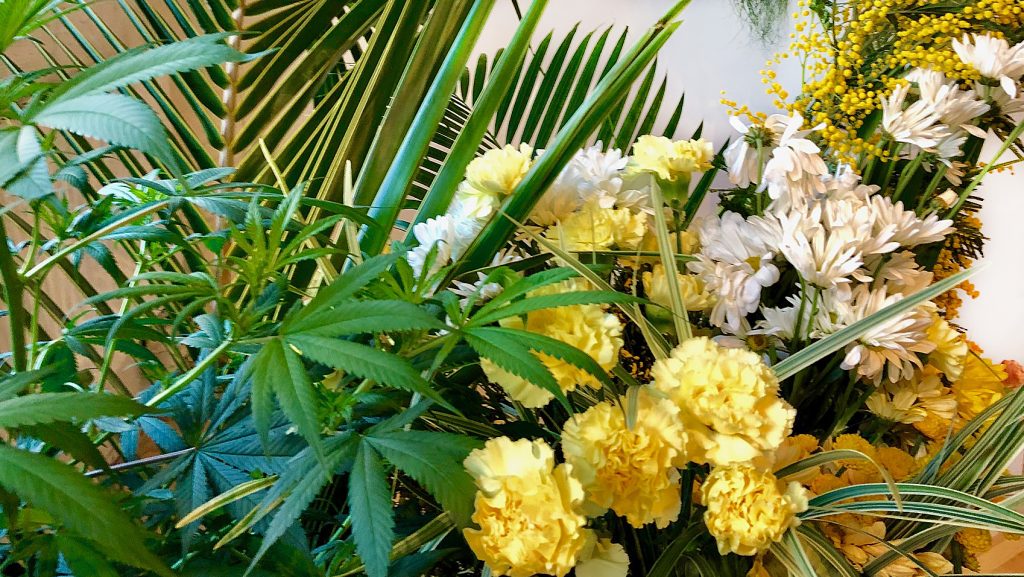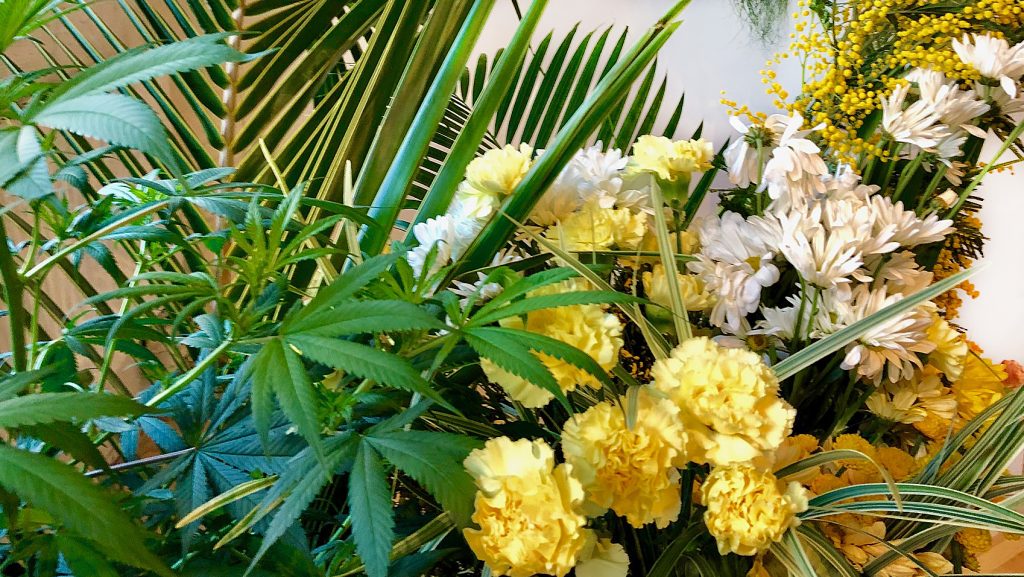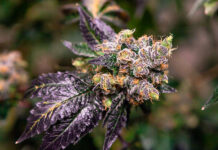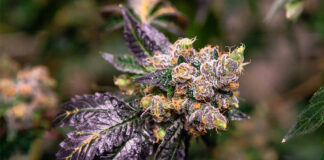
Amid a spray of colors — fuchsia, electric orange, pale yellow, and bright white — and a wild profusion of shapes created by flowers, fruits, and vegetables, a plant not normally found in flower arrangements found a home at New York’s Museum of Modern Art PS1, in Long Island City, Queens: the variety of Cannabis sativa known as hemp.
The humble plant known more for its medicinal and industrial uses was celebrated for its aesthetic value in the work of floral designer Amy Merrick as part of “Hothouse: Flowers and Cannabis Culture with Broccoli Magazine,” held Feb. 3, 2019. The event also hoped to normalize cannabis, a plant that’s been demonized for more than 70 years, in all its forms.
“I think it’s important for us to have events like this to decouple this idea of [cannabis] having to be an underground thing that people don’t speak about and to celebrate the spiritual and social qualities of this plant,” said Georgia Frances King, the ideas editor for Quartz, to the audience gathered for a panel discussion on the role of flowers in the normalizing of cannabis. “The more we can see weed casually presented in this beautiful way the quicker we can start to break down those barriers.”
“Hothouse: Flowers and Cannabis Culture with Broccoli Magazine” featured hemp flowers mixed in with flowers and fruits and vegetables found in New York City boedgas. The arrangements were by floral designer Amy Merrick and were discussed Feb. 3, 2019, at the Museum of Modern Art PS1 in Queens, New York. (Photo by Andrew Amelinckx)
King moderated the panel as part of the day’s events presented in conjunction with the cannabis culture-themed Broccoli magazine. The installation and panel discussion was one of the VW Sunday Sessions, which highlights artists responding to social and political issues through a variety of media, and was the culmination of many months of conversations with Anja Charbonneau, the editor in chief and creative director for the magazine, according to Alex Sloane, an assistant curator at the museum.
Besides exotic tropical flowers such as heliconia, there were carnations, bananas, broccoli, grapes, and lemons, among other elements in the floral arrangements. Merrick often designs her pieces by gathering the materials from the surrounding landscape.
For the PS1 show, it was a bit of a challenge since it was in New York City in early February. As she walked around the city she realized that besides the many bare tree branches and dirty sidewalks, there were “super-vibrant bodegas on every corner full of all these flowers and all of this produce. I thought it would be really fun and interesting to make these botanical bodega ecologies,” she told the audience.
Cannabis figures prominently in floral arrangements inspired by the Japanese art of ikebana. Amy Merrick studied Japanese floral arrangements, and it shows in her works that were discussed at the Museum of Modern Art’s PS1 in Queens, New York, on Feb. 3, 2019. Broccoli, a cannabis culture magazine, presented the discussion “Hothouse: Flowers and Cannabis Culture with Broccoli Magazine.” (Photo by Andrew Amelinckx)
The addition of hemp was an exciting one to King. She had been obsessing over photos from the 1940s and ’50s, when cannabis grew wild across much of New York City and was eventually cut down and hauled away by city workers.
“There are these hilarious pictures of police officers with pickup trucks full of weed trying to do this cleanup process,” King said. “I thought it would be fun to bring it back to New York City.”
The hemp used in the flower arrangements came from Hudson Hemp, an association of farmers growing CBD hemp in New York‘s Hudson Valley. “We’re the first company to put cannabis in MoMA,” John Gilstrap, Hudson Hemp’s chief operating officer, told Weedmaps News. But getting permission to bring hemp into the museum was a mission that involved insurance coverage, careful logistics — and the 2018 Farm Bill that federally legalized hemp — according to Gilstrap.
Cannabis as Wonder Plant
During the panel discussion, Charbonneau spoke of the many connections between flowers and cannabis. How the plant is a teacher that helps people with sharing, communication, and learning processes.
“[Cannabis] allows you to go into yourself in a really interesting way and communicate with the feelings you are having,” Charbonneau said. “It’s a thing that you can share with people as an offering. I think that’s one of the reasons why it’s such a special connector”
For Mennlay Golokeh Aggrey, a Mexico City-based cultivator and author of “The Art of Weed Butter,” growing cannabis has transformed her life in many ways, including honing her sensitivity and connectivity to the world around her.
“It translates and transfers into all the other things of your life, whether it be your houseplants, or your hair, or your nails, or just someone you can tell needs a little bit of water,” Aggrey said. “And you feel that in the growing community where everyone is trying to take care of the same thing. We want to have a clean, healthy, happy collection of weed to share with the rest of the world.”
We want to have a clean, healthy, happy collection of weed to share with the rest of the world. Click To Tweet
Both Merrick and Alice Grandoit, an experiential designer and creative strategist based in Los Angeles, studied ikebana, the Japanese art of flower arranging. For Grandoit, cannabis is both a natural part of her life as well as an integral part of her Ikebana practice.
The familiar symbolism of a cannabis leaf, which Charbonneau said was “kind of played out” and “not something people find very elegant or beautiful,” is able to be transformed through ikebana, helping to “highlight how elegant they are and how poetic the shapes can be.”















